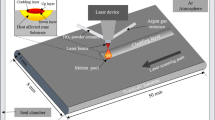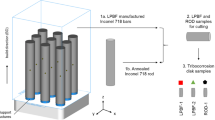Abstract
In the active brazing of SiC by copper-based alloys, the effects of various active elements such as titanium, vanadium, niobium and chromium on the wetting, microstructure and bond strength are investigated. In wetting, Cu-Cr alloys have the lowest wetting angles on SiC of 10°–20° depending on the chromium content. SiC is decomposed on contact with alloy melts during brazing. Carbon and silicon released from this decomposition of SiC react with active elements to produce their carbides and suicides at the interface. The reacted layers have different microstructures depending on the brazing alloys, but Cu-Ti and Cu-Cr alloys show similar microstructure, as do Cu-V and Cu-Nb alloys. In the four-point bend tests, the brazed joints of Cu-5 at % Ti, Cu-5 at % V and Cu-5 at % Nb alloys have similar bend strengths of 86.9, 80.3 and 92.4 MPa, respectively. The brazed joints of Cu-2 at % Nb alloys show a high bend strength of 154 MPa, although the wetting angle is a little higher, at about 60°. Niobium is found as a new active element of copper-based alloys to braze SiC. Cu-Nb alloys are promising for substitution for Cu-Ti alloys.
Similar content being viewed by others
References
T. ISEKI, H. MATSUZAKI and J. K. BOADI, Am. Ceram. Soc. Bull. 64 (1985) 322.
D. H. KIM, S. H. HWANG and S. S. CHUN, J. Mater. Sci. 26 (1991) 3223.
I. NOBUYA and S. TADATOMO, in “Ceramics Bonding Engineering” (Nikkan Kougyou Press, Tokyo, Japan, 1990) p. 174.
H. K. LEE and J. Y. LEE, J. Mater. Sci. Lett. 11 (1992) 550.
H. K. LEE, S. H. HWANG and J. Y. LEE, J. Mater. Sci. 28 (1993) 1765.
G. G. GNESIN and Yu. V. NAIDICH, Sov. Powder Met. Metal. Cerm. 89 (1970) 410.
A. J. MOORHEAD and H. KEATING, Weld. J. 65 (1986) 17.
T. B. MASSALSKI, in “Binary Phase Diagram” (ASM, Metal Park, OH, 1986), p. 559, 936 and 974.
T. OKUO, Y. KUSADA and Y. AIYAMA, J. High Temp. Soc. 11 (1985) 186.
Author information
Authors and Affiliations
Rights and permissions
About this article
Cite this article
Lee, H.K., Lee, J.Y. A study of the wetting, microstructure and bond strength in brazing SiC by Cu-X(X = Ti,V,Nb,Cr) alloys. JOURNAL OF MATERIALS SCIENCE 31, 4133–4140 (1996). https://doi.org/10.1007/BF00352679
Received:
Accepted:
Published:
Issue Date:
DOI: https://doi.org/10.1007/BF00352679




